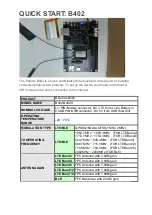
132
Internal configuration of modules is as follows:
Module (A)
Set Module operating mode to Modbus RTU Slave or MT Slave
Set Modbus ID number of the module to a value different than zero (f.e.1)
Set Authorized IP to 1 and add the IP assigned to module MT-101 operating in Modbus RTU
Master mode (options allowing data transmission and reception have to be checked in).
Module (B)
Set Module operating mode to Modbus RTU Master
Set Modbus ID number of the module to a value different than zero (f.e.2)
Set Authorized IP to 1 and add the IP assigned to module MT-101 operating in Modbus RTU
Master mode (options allowing data transmission and reception have to be checked in).
Fill in the Routing table setting IP address and Modbus ID assigned to MT-101 operating in
Modbus RTU Slave (or MT Slave) mode.
The device playing role of master (C) should be connected to PORT 2 of module (B) and
query resources of address assigned to module Slave (A). The master can query module
(B) provided that Modbus address of module (B) is sent along.
A system configured this way secures permanent access to all internal resources of the
Slave including SMS services in situations defined during configuration. If the master unit is
a PC running on Windows, the MT Data Provider (OPC Server) delivered with the module is
the best solution for communication. MT Data Provider serves both querying and unsolicited
messaging on the basis of Data sending rules defined during modules configuration.
Access to internal resources of modules in a telemetry network is similar to that described
above. The only difference is the number of network nodes and assignment of unique
Modbus IDs necessary for precise addressing of queries associated with it. Remember to
put all slaves IP addresses into Master module's IP list along with corresponding Modbus ID
and make sure that reading and writing is enabled.
Содержание MT-101
Страница 1: ......
Страница 129: ...126 11 7 Drawings and dimensions ...
















































